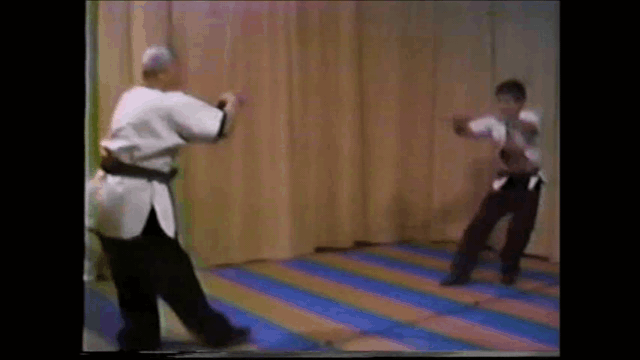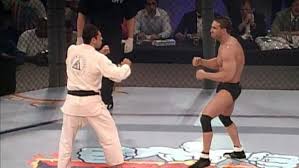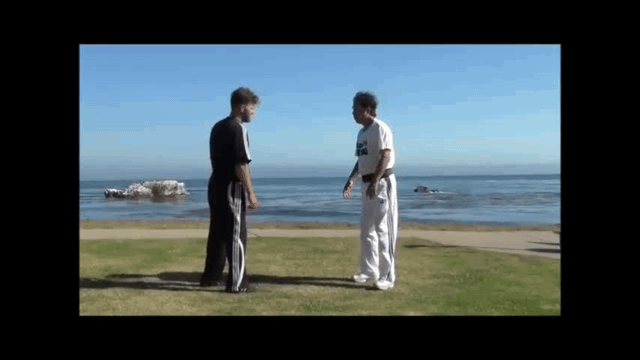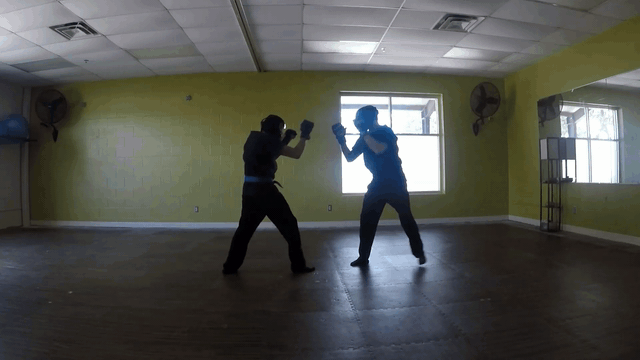I started to wonder recently, what is exactly the difference between a block and a guard? When is we using a guard versus a block and why?
blocks in patterns are misinterpretations passed on.
Follow along with the video below to see how to install our site as a web app on your home screen.
Note: This feature may not be available in some browsers.
I started to wonder recently, what is exactly the difference between a block and a guard? When is we using a guard versus a block and why?
I'm still working on this one.Is this guard or block?
It's not
- guard because you are moving your arms.
- block because you are not blocking any incoming punch.
You move your arms to
- protect space in front of you.
- sense your opponent's intention.
- make contact on your opponent's arm/arms.
- ...

Some Kenpo Karate guys like to use guard such as:or fake weaknesses

- You throw a right jab toward your opponent's face.I am having a hard time understanding how the forearm rotation makes a significant difference.

I'd say there's a small grey area between them, but mostly I consider a clear distinction: a block has an aggressive element by the arm. The arm moves to intercept the strike. It doesn't have to be a strike (thinking of a push block), but the arm is intercepting, independent of what the body is doing.When you are in a guard position, when a punch comes toward you, if you freeze your shoulder and arms, you only rotate your body and let your guard to meet with the incoming punch. Is that guard, or block?
For example, when a lion attacks a rhino. The rhino turn it's body and let it's rhino horn to face the incoming lion's bite. Is that guard, or block?
Is a "moving guard" the same as "block"?
But when you rotate your body, your guard will move with you too. When a rhino is running, is it's rhino horn a guard, or block?
IMO, a guard can be a block. But a block cannot be a guard.
Why can't you step in with a guard?A body rotation is quite different from taking a step, which is often done with a block, never with a guard.
Do you personally have a Rhino's horn on the end of your face?
Point being we have opposable thumbs.
Indeed. Doing so helps cover as you close the gap. And you can certainly have one hand in a guard (check) position as the other blocks or strikes. This active hand's action should create openings and allow the guarding hand to then attack or otherwise open up the opponent, furthering the attack. Furthering the attack - This is the ideal purpose of any check, guard, block or strike.Why can't you step in with a guard?
The only concern is the 1 arm guard is not very strong. The 2 arms rhino guard is stronger. You can hide your head behind it. But you lose some of your striking ability. If you use rhino guard as a quick entering strategy. It can be a good idea.Indeed. Doing so helps cover as you close the gap. And you can certainly have one hand in a guard (check) position as the other blocks or strikes. This active hand's action should create openings and allow the guarding hand to then attack or otherwise open up the opponent, furthering the attack. Furthering the attack - This is the ideal purpose of any check, guard, block or strike.


Fully agree such as the ready hand of a sonnal momtong makki. The explanations of the ready hand are wide and varied but the block always serves a dual purpose.Indeed. Doing so helps cover as you close the gap. And you can certainly have one hand in a guard (check) position as the other blocks or strikes. This active hand's action should create openings and allow the guarding hand to then attack or otherwise open up the opponent, furthering the attack. Furthering the attack - This is the ideal purpose of any check, guard, block or strike.
I agree you can. I believe I said that to make a point and invoke a response/question from acronym.Why can't you step in with a guard?
Because it links the two arms, it leaves you open to someone clearing both at the same time (and moving both shoulders at once, too). I’d rather have a weaker guard that can’t be so easily removed.The only concern is the 1 arm guard is not very strong. The 2 arms rhino guard is stronger. You can hide your head behind it. But you lose some of your striking ability. If you use rhino guard as a quick entering strategy. It can be a good idea.


I just watched one of my videos of this where my guard was getting a good beat down and torn apart.The only concern is the 1 arm guard is not very strong. The 2 arms rhino guard is stronger.
You are right, when your opponent deals with your guard, he may forget about your kick/sweep.I don't necessarily need my guard to stop punches, I'm happy if it slows down punches or occupies my opponent.

If that's the goal then it would work. You would definitely have to be really aggressive with it, You couldn't just go in half willing.You are right, when your opponent deals with your guard, he may forget about your kick/sweep.
The main purpose of my rhino guard is to use it to separate my opponent's arms away from his head and obtain a head lock.

